|
||||||||
|
|
|
2016-05-17 ArtNo.45748
◆Review:The baptism of the Holy Spirit (Sun Face Buddha, Moon Face Buddha)
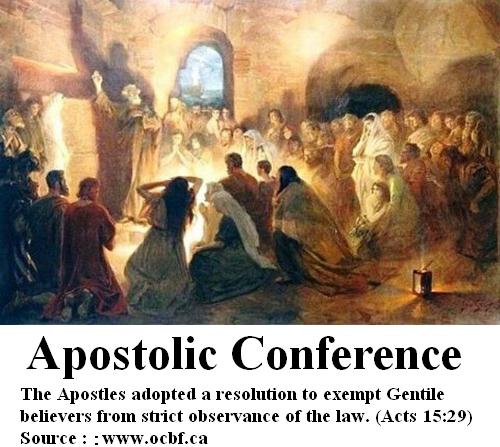 Some men came down from Judea to Antioch and were teaching the brothers: "Unless you are circumcised, according to the custom taught by Moses, you cannot be saved." This brought Paul and Barnabas into sharp dispute and debate with them. So Paul and Barnabas were appointed, along with some other believers, to go up to Jerusalem to see the apostles and elders about this question. (Acts 15:1-2) ○The context of the first Apostolic Conference The Primitive Church was established at the meeting place of the Essenes adjacent to the residence of the High Priest Caiaphas, barely one and half month after the Crucifixion, through the integration of the church movement occurred among gentiles of the Mediterranean coast and the movement for the reform of Judaism occurred in Israel which is said to have been pioneered by John the Baptist and Jesus. However, a conflict between Hebraists (Jews who spoke Hebrew and Aramaic fluently), who had wanted to maintain the identity of the religion of the Jews, and Hellenists (the gentile believers who were neither familiar with Hebrew or Aramaic but used Greek as intermediate language among them), who had wonted to obliterate the Jewish odor, was immediately surfaced and the Hellenic believers forced to withdraw from Jerusalem in the wake of the martyrdom of Stephen. Therefore, Paul and Barnabas founded a new Church in Antioch of Syria for the Hellenist believers. However, some missionaries came down from Judea to Antioch and were teaching the brothers: "Unless you are circumcised, according to the custom taught by Moses, you cannot be saved." This brought Paul and Barnabas into sharp dispute and debate with them. So Paul and Barnabas were appointed, along with some other believers, to go up to Jerusalem to see the apostles and elders about this question. Then so-called "the first Apostolic Conference" was held. 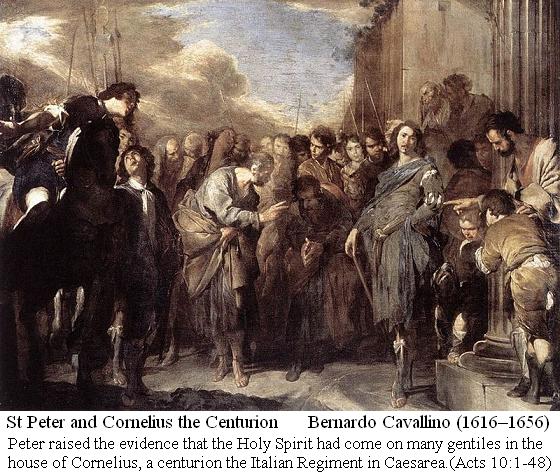 Peter raised the evidence that the Holy Spirit had come on many gentiles who had heard his message in the house of Cornelius, a centurion in what had been known as the Italian Regiment in Caesarea, who had invited Peter to preach them (Acts 10:1-48) and said, "God made no distinction between us and them. Now then, why do you try to test God by putting on the necks of them a yoke that neither we nor our fathers have been able to bear? (Acts 15:7-11)" James, the head of the Jerusalem Church, also stood up and said, "Peter's description is in agreement with the words of the prophets in The Book of Amos, as it is written: 'On the day of the restoration of Israel, the Gentiles also seek the Lord. (Amos 9:11-12)' It is my judgment, therefore, that we should not make it difficult for the Gentiles who are turning to God." And he proposed, "The gentile believers should only be required to abstain from food polluted by idols, from sexual immorality, from the meat of strangled animals and from blood. For Moses has been preached in every city from the earliest times and is read in the synagogues on every Sabbath." (Acts 15:13-21) Thus, the Hebraist believers and the Hellenist believers came to a compromise. Then the apostles and elders decided to write to the Antioch Church and other gentile churches to notice them above the proposal by James as the resolution of the first Apostolic Conference. And the Council also acknowledged Paul and Barnabas' status of the Apostle to the gentiles and James, Peter and John should go to the to the circumcised to preach. (Ga 2:9) Though the Hebraists and the Hellenists achieved a consensus on the baptism with the Holy Spirit taught by Jesus as a foundation of their church movement, they argued each other whether the color of Judaism should be left on their movement or how much should be left. Even in the Hebraists themselves or in the Hellenists themselves, there were very significant differences. Stephen, a leader of the Hellenist who was martyred, seems to have denied the authority of the temple and even the law of Moses itself. In contrast, the members of the Synagogue of the Freedmen, as it was called, were Hellenists, too, as long as they spoke Greek. However they held the faith even closer to Jewish fundamentalism than Hebraists. Although Peter from Galilee, of which residents had been forced to convert to Judaism by the Hasmonean dynasty, seems to have felt the Mosaic law as a yoke that neither they nor their fathers had been able to bear, James the Less, who had been the legitimate lineage of the High Priest representing both the Davidic royal family as well as a priestly Aaronic Lineage, performed all the practices enjoined by that rule of life with rigorous exactness and had won the high honor of the Righteous. Concerning circumcision of the Gentiles, Peter and James the Less seem to have intended to let the believers themselves decide, while Paul absolutely rejected. ○Origin of circumcision 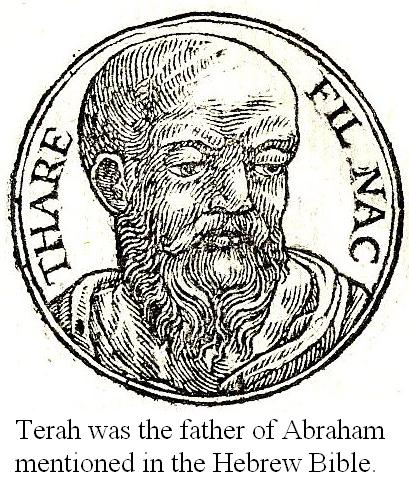 Following his father Terra who was a polytheist (Joshua 24:2), Abram (Abraham's original name) left Ur in Chaldean region of Mesopotamia and emigrated to Haran in Padang Alam region near the upstream of the Euphrates river. When his father died, he started again to travel to south along the Mediterranean coast and arrived in Canaan. (Genesis 11:31-12:5) Because of a famine, he and his family had to once leave Canaan and move to Egypt. But when they returned to Canaan, Abram covenanted with God and circumcised himself and all members of his clan as the sign of the covenant between God and him and changed his name from Abram to Abraham and changed the name of his wife (his half sister) too from Sarai to Sarah. (Genesis 12:10-17:27) Abraham and his clan seem to have decided to live in Canaan forever and to have discarded their old beliefs in polytheism and converted to indigenous monotheism. They also seem to have learned Hebrew from Canaanite, according to Wikipedia. However, Abraham and his family, even after they had moved into Canaan, seem to have kept nomadic life. So when their livestock increased beyond the allowable range of the land, they divided their flock and herd and let a part of their family to move to another place seeking new pasture. For this reason, they seem to have been always regarded as foreigners by other agricultural people in the surrounding area until they formed their own nation. By the way, Abraham, who was 75 years old when his father died, begot his first child, Ishmael, of his wife's Egyptian servant Hagar at his 86 years old, circumcised all members of his clan at his 99 years old and begot his second child, Isaac, of his lawful wife, Sarah, in the next year. There are similar episodes in chapter 12 and 20 respectively of the Book of Genesis; Abram and Abraham sent Sarai at her more than 80 years old and Sarah at her more than 90 years old, saying not his wife but his sister, to the Egyptian king and the king of Gerar to serve them. There are another episode as follows, too. Aged Lot, a nephew of Abram begot two sons of his eldest and second daughters respectively, and these children became the ancestors of the Moab and the Ammon. Following his wife Sarah's death at her 137 years old, Abraham again took a wife called Keturah and begot Zimran, Jokshan, Medan, Midian, Ishbak and Shuah and each of these sons became the ancestors of different tribes. Abraham died at 175 years old and was buried in the cave of Machpelah of Hebron in the land of Canaan together with his wife Sarah by his sons Isaac and Ishmael.(Genesis 25:1-10) Therefore, it is suggesting that there were many legends and mythologies regarding model persons for Abraham and these legends and mythologies were unified into the Book of Genesis in order to integrate the various tribes in Canaan or even in the whole world into Abraham's lineage. ○Mosaic law 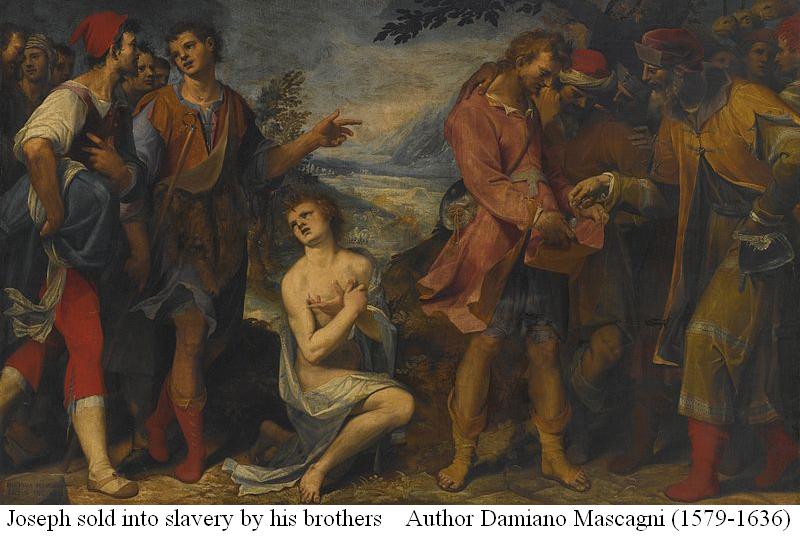 Although Abraham's great-grandson Joseph was sold to Midianite merchants as a slave by his brothers, he was placed in charge of the whole land of Egypt (Finance Minister or Prime minister?) by the Pharaoh. He moved his entire family to Egypt when a famine came. Abraham's descendants, who had again fallen into slavery after a period of time, led by Moses and escaped from Egypt. So-called the law of Moses, that forms the foundation of Judaism, was formed through a period of time when they wandered the Sinai Desert for 40 years, conquered the indigenous people and finally returned to Canaan. The patriarchs beginning from Abraham avoided to take wives from the local but preferred to take from Haran, their polytheistic homeland, even after they had converted to indigenous monotheism. As the result, the customs of Haran, such as Teraphim (Patron god faith or Idolatry) and incest were maintained among them and often resulted in the disputes at the time of the selection of a successor or heirs of properties. Therefore Moses seems to have tried to wipe out the polytheistic customs of Haran and Egypt through establishing the strict precepts. ○Gnosticism 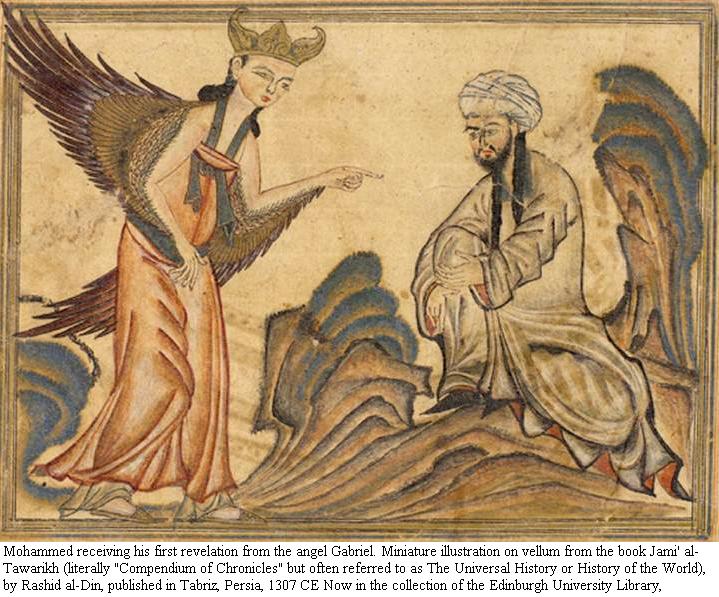 After the death of Alexander the Great, who conquered a vast area from the Mediterranean Sea to India, Israel came under the control of the Seleucid Empire Syria. The Maccabean family expelled the Seleucid Syrian rule and established the Hasmonean dynasty. Hasmonean dynasty, which had built the first unified nation in Palestine except in the mythical era, not only forced non-Jews to convert to Judaism but also promoted modernization absorbing Hellenistic culture in a big way. On the other hand, in Egypt, under the rule of the Ptolemy dynasty, not only the translation of The Old Testament into Greek was initiated, but also the tide of Gnosticism occurred under the environment of Syncretism, cultural fusion of east and west, such as Egypt, Persia, India and so on and the scholars in Alexandria attempted to fuse Judaism with Greek philosophy. Thus, by the time that Jesus was born, the overwhelming majority of Jews used neither Hebrew nor Aramaic but used Greek. And Gnosticism not only influenced heavily on the church movement that had occurred in the Mediterranean coastal areas but also became the ideological foundation of the baptism with the Holy Spirit preached by Jesus. Gnosticism also impacted the Mahayana Buddhism movement in India. Especially, the baptism of the Holy Spirit appears not only to have blossomed as the cultures of Zen Buddhism in China and Japan after being having conveyed to India by Thomas but also to have contributed to the birth of Islam. ○Sun Face Buddha, Moon Face Buddha 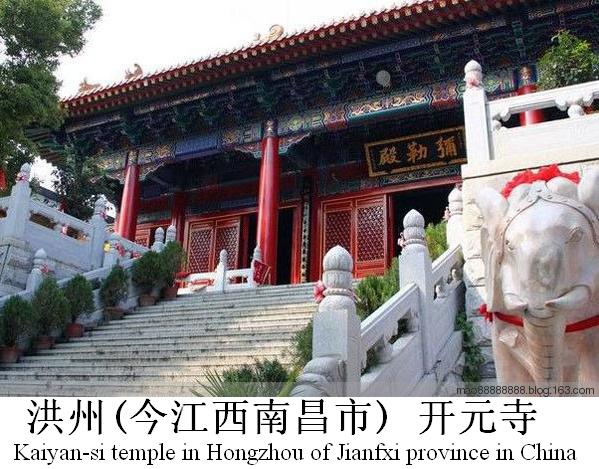 There was a Zen master called Mazu Daoyi (709-788) who had established Hongzhou school, one of major sects of the Zen Buddhism, based at the Kaiyan-si temple in Hongzhou of Jianfxi province in China during the mid of the Tang Dynasty. He emphasized everyday life itself than studying scriptures or meditation and taught students using extraordinary actions and tactics suited to each occasion and turned out 88 famous Dharma-sealed disciples including Baizhang Huaihai (720-814) and Nanquan Puyuan (748-835). He is also known with his many wise remarks, such as, "The ordinary mind is the way," "Each mind is a living Buddha," and so on. However, Great Master Ma has recently looked fidgety. The temple superintendent became suspicious and asked him, "Teacher, you look uncomfortable. What's happening to you?" The Great Master answered, "Sun Face Buddha, Moon Face Buddha." "Sun Face Buddha" is ranked the 58th in the 1000 Buddhas who appear in this world and his life time is horribly long, that is, 1,800 years. In contrast, ranked the 202nd "Moon Face Buddha's" life time is only one day and one night. Apparently, the Great Master Ma, who was nearly 79 years old, seems to have thought that the day of reckoning for him was coming. The enlightenment of Zen Buddhism, which is declared, "When it is cold, the cold kills you; when it is hot, the heat kills you," is prepared that there is nothing else to do but to sorrow when you feel lonely and to wail when you are sad. "The ordinary mind is the way" also describes the same idea. When Nobunaga Oda burnt down the temple, and the temple priest, Kaisen Joki, who had written the well-known words, "If your desire extinct, fire itself would be cool," must have writhed in agony and died and testified his enlightenment. Thus, Zen Buddhists can die peacefully under any circumstances. When Japan's leading Zen monk, Ikkyu Sojun, who composed many comic tanka poems, such as "We get up, work, sleep and eat; This is our world. All we have to do after that, - Is to die," "Amen Sakyamuni Buddha! Oh corrupt this world! Hell! Pain! Happy! It was dumb of you to say this or that," was close to death from malaria at Shuonan (Ikkyuji Temple) of Kyotanabe City in Kyoto, he is said to have confessed, "I do not want to die." 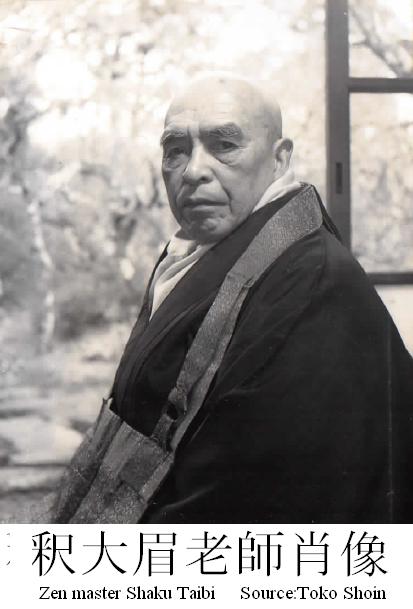 By the way, Zen master Shaku Taibi (1881-1964), who had been the mentor of Tokoshoin's Dawn Zazen Class, turned his face to right and said "con, con (a cry of fox in Japanese)" and turned to left and said, "chu, chu (a cry of mouse in Japanese)" regarding "Sun Face Buddha" and "Moon Face Buddha" when he explained this koan recorded in 'The Blue Cliff Record; The 3rd Case.' ○The essence of the baptism of the Holy Spirit Jesus, too, who had entered Jerusalem riding on a donkey as the king of Israel, suddenly began to waver and be troubled after being paid a visit by some Greeks and he said, "Now my heart is troubled, and what shall I say? 'Father, save me from this hour'? No, it was for this very reason I came to this hour." (John 12:27) Jesus' agony looks to have been growing more and reached a climax in the prayer of Gethsemane and the screaming on the cross, "Eloi, Eloi, lama sabachthani?--which means, My God, my God, why have you forsaken me?" (Mark 15:34, Matthew 27:46) The personal pupils of Jesus who witnessed the agony of Jesus, who even could not writhe on the cross but could only shriek, seem to have found the essence of the baptism of the Holy Spirit at that moment and to have written his agony in the Gospels. 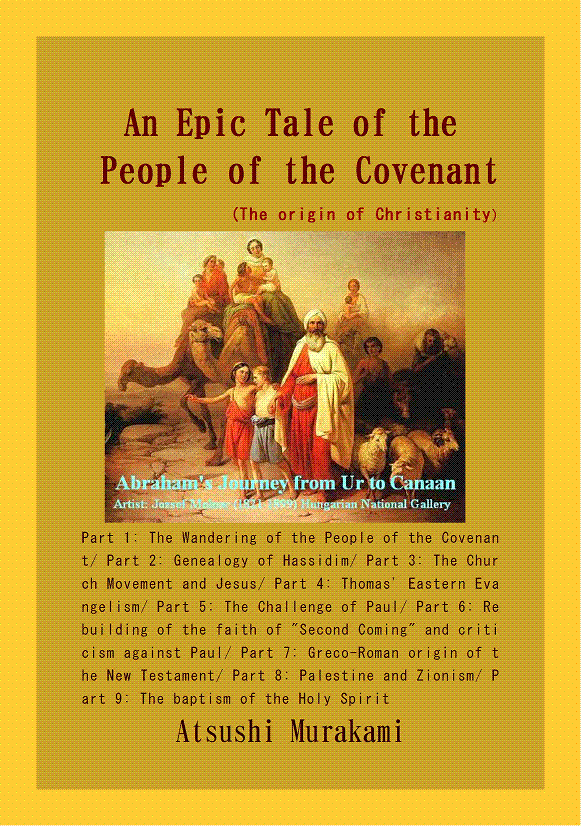 ○What is "Baptism with The Holy Spirit"? According to the dialectic of the Gospel of John, 【Thesis】"A man can possess eternal life through accepting testimony of the Son of man and being baptized by him." (John 5:24) 【Anti-thesis】But "The one who comes from the earth cannot accept the testimony by one from heaven."(John 3:32) How then can a man possess eternal life? 【Synthesis】"If you want to be baptized with the Holy Spirit, you can just go back to the word which was with God in the beginning (John 1:1) and certify that God is truthful. (John 3:33)" When he said, "You are Huichao," Zen Master Fayan thrusted vivid Self in Huichao in front of his eyes. Purchase here [Reference] ○Tokoshoin 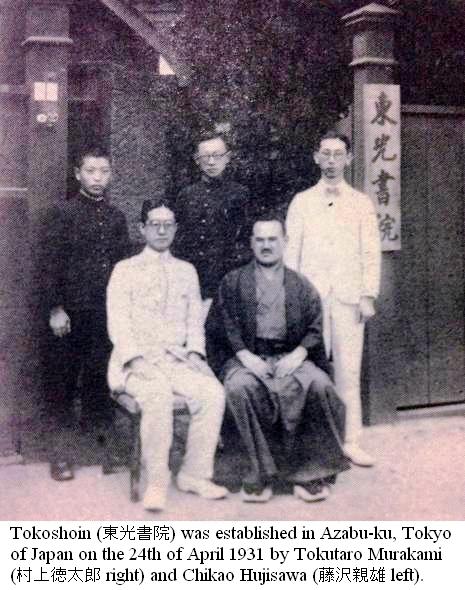 [Founding] It was established in Azabu-ku, Tokyo of Japan on the 24th of April 1931 by Tokutaro Murakami, who was in charge of the dean first and the director later. It was moved to Shinbashi-cho, Shibuya-ku, Tokyo on July 1937. [Terms] 1. Do not covet the temporary comfort, but be ambitious for the world. 2. Vow to foster virtue and intelligence, but do not insist on frivolous thought. 3. Be prepare to sacrifice yourself when the time has come. [Scriptures for daily life] "The Heart Sutra", "Hakuin Zenji Zazenwasan(Anthem of Zazen written by Hakuin)", "The four great vows", "Mitsugonin Confession", etc. 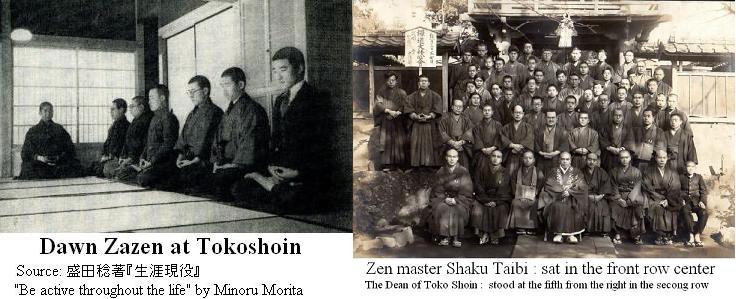 [Daily schedule] 4:30 am: To wake up and clean rooms, corridor, toilet and courtyard etc. 5:30 am: To attend Zen meditation and listen the sermon of the dean. 6:30 am: To take breakfast together with others. 6:00 pm: To take dinner together with others. The end of each month: To practice Zen under Zen Master Taibi Shaku, the chief priest of the DaiChuji Temple of Numazu City. Twice a year: To participate in sesshin (one week intensive course of Zazen). The headquarters in Shibuya-ku, Tokyo was abolished by the air strikes on May 24, 1945. Toko Shoin was rebuilt in Higashimatsuyama city, Saitama Prefecture in Japan on April 1954. ○Former Aomori University President Minoru Morita's encounter with Tokoshoin 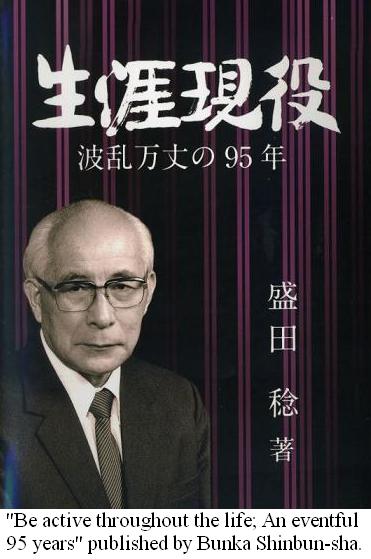 Mr. Minoru Morita (Board Chairman of Aomori Yamada Academy), who was enrolled in Tokoshoin when he was a student of the University of Tokyo, is looking back over his encounter with Tokoshoin as follows in his memoir "Be active throughout the life; An eventful 95 years" published by Bunka Shinbun-sha. My father chose Mr. Seiichi Shimizu as my guardian and I had no objection to that. I received a letter from him around the end of 1940. An article of the Yomiuri Shimbun (One of the leading daily newspaper in Japan) introduced sensationally a private school of zazen called Tokoshoin, which was near Ebisu Station of Shibuya in Tokyo, was enclosed in the letter. He encouraged me to enroll in this private school. The contents of the article were roughly as follows. Mr. Tokutaro Murakami, the president of Tokoshoin, who had become an assistant professor of Toua Doubun Shoin (East Asian Literary School) in Shanghai in China after the graduation of that school, established Tokoshoin having felt some sense of mission. According to him, the international community must be a free society managed on the basis of the moral order. If it is so, the human education must be thoroughly redone. Tokoshoin is fostering such talents to work for this object through letting them master the Eastern thought. Actuary a batch of young people, who have the ambition, not only from Japan, but also from Mongolia and China, are working hard to zazen every day. I decided to enroll at Tokoshoin on my own will and my father also agreed to my decision. After having spent the New Year in Shichinohe, I visited Tokoshoin on one day in January and was allowed to be enrolled. -- omit -- After all, I could not practice even the susokukan (method to achieve spiritual concentration and stability by counting the number of breaths, the first step of zazen) that day. After zazen, I listened to a sermon of the teacher Murakami. I was impressed by his sermon which was comprised not only Buddhism but also Confucianism, Christianity and Taoism. Here, it may be necessary to clarify the origination of his philosophy. Mr. Murakami studied zen under Zen Master Taibi Shaku and was given the Dharma name by him. Zen Master Taibi Shaku was one of the most great disciples of Soen Shaku, who had served as a director of Enkakuji temple and Kenchoji temple and had been the outstanding monk leading Japanese Rinzai School of Zen Buddhism. -- omit -- While I was working hard at practicing zazen, Japan was heading for the Pacific War -- omit -- ○Cause of Former Prime Minister Yasuhiro Nakasone's entrance into Tokoshoin 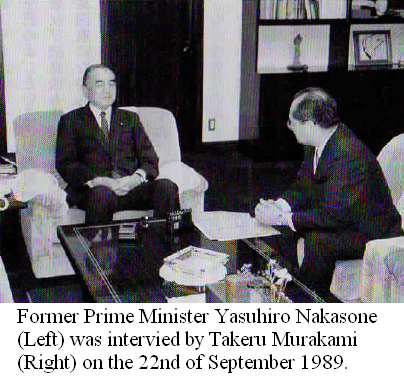 Q:Our bulletin "Eko's" number of issue will be 600 in this September. In this occasion, I would like to hear your memory about late Tokutaro Murakami and your thoughts about Eko. It was in 1941 when you first came to Tokoshoin, wasn't it? A:At that time, I had a classmate of Shizuoka High School in the former educational system. That guy, who called Ohyachi, said, "The war is coming soon. I have already experienced studying in university. But, now, I am feeling something missed to study." And he said, "I have heard about Tokoshoin, where people are practicing Zazen. How do you think about it?" I said, "Yes, I too, like very much Zazen." Thus, I visited Tokoshoin for first time. It was in Shinbashi-cho, wasn't it? (...Read More) Your Comments / UnsubscribeSEAnewsFacebookSEAnewsGoogleSEAnews eBookstoreSEAnews eBookstore(GoogleJ) |
|
[Your Comments / Unsubscribe]/[您的意见/退订]/[ご意見/配信停止]
Please do not directly reply to the e-mail address which is used for delivering the newsletter. 请别用递送新闻的邮件地址而直接回信。 メールをお届けした送信専用アドレスには返信しないで下さい。 |